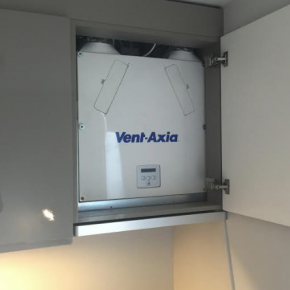
Vent-Axia Supports Landmark Report by Royal Colleges on Indoor Air Quality
Leading British ventilation manufacturer Vent-Axia has welcomed the latest joint report by the Royal College of Paediatrics and Child Health (RCPCH) and the Royal College of Physicians on the health impact of indoor air quality (IAQ) on children and young people.
The report, entitled ‘The inside story: Health effects of indoor air quality on children and young people’, was published on 28 January. It explains there is growing evidence that respiratory problems among children may be exacerbated by indoor air pollution in homes, schools and nurseries.
This comprehensive landmark report, involving a systematic review of 221 studies, shows evidence linking indoor air pollution to a number of childhood health problems, including asthma, wheezing, conjunctivitis, dermatitis, and eczema.
Within the report, sources of indoor air pollution are cited as including smoking, damp, the burning of fossil fuels and wood, dust, chemicals from building materials, furnishings, aerosol sprays, and cleaning products. The document also warns IAQ tends to be worse in low quality housing, where properties are inadequately ventilated.
Report recommendations say local authorities should have the power to require improvements in local authority schools and houses where air quality fails to meet minimum standards.
To do this, it advises revising the Building Regulations by setting robust legally binding performance standards for IAQ including ventilation rates, maximum concentration levels for specific pollutants, labelling materials and testing appliances, introducing air quality tests when local authority construction is complete and before building sign-off and checking compliance tests after the construction stages and assessment of buildings once occupied and in use.
 Jenny Smith, Head of Marketing at Vent-Axia, commented: “At Vent-Axia we are committed to improving indoor air quality and so public health. With Public Health England attributing between 28,000 and 36,000 deaths a year from long-term exposure to air pollution, it is the biggest environmental threat to health in the UK.
Jenny Smith, Head of Marketing at Vent-Axia, commented: “At Vent-Axia we are committed to improving indoor air quality and so public health. With Public Health England attributing between 28,000 and 36,000 deaths a year from long-term exposure to air pollution, it is the biggest environmental threat to health in the UK.
“Until now outdoor air pollution has been at the forefront of air pollution debates but this report confirms the vital importance of IAQ to health.
“It therefore advises an urgent step change with a number of recommendations designed to radically help improve the indoor air we breathe.”
Another key recommendation from the report is that local authorities should follow the National Institute of Health and Care Excellence (NICE) guidance ‘Indoor Air Quality at Home’, which was published earlier this month.
The document provided detailed information and advice on how to reduce exposure to indoor pollutants and so help protect health. The publication of this guidance set in stone the importance of good IAQ, highlighting the significant part effective ventilation plays in helping combat indoor air pollution in the home.
Confirming the significance of IAQ’s impact on health the Royal Colleges’ report calls for a cross-governmental committee to co-ordinate working in health, environment, education and homes for indoor air quality and recommends developing a national strategy and policy for IAQ.
The strategy should designate a Government Cabinet lead on the issue of IAQ and there should be steps to raise public awareness and understanding. There is also a recommendation for the inclusion of IAQ within Air Quality plans mandated by Government.
Other recommendations from the Royal Colleges’ report include calls for local authorities to offer free indoor air testing for residents, as well as a national fund to support improvements for low income families.
Meanwhile, to evaluate IAQ risks in homes and schools, the report recommends improved resources for Environmental Health Officers. The report also advises on an update of existing instruments, such as the Housing Health and Safety Rating Systems to include more evidence on a wider range on indoor air pollutants. There are also calls for a ‘clean house’ check-up system similar to current Energy Performance Certificates and regulation of air-cleaning devices.
Since 1936 Vent-Axia has been working hard to provide ventilation solutions to improve IAQ for households. For new build homes, Vent-Axia’s Sentinel Kinetic mechanical ventilation with heat recovery (MVHR) system boasts an impressive 94% heat recovery.
Vent-Axia’s Lo-Carbon Sentinel Kinetic Cooker Hood combines a cooker hood with MVHR unit in one.
A vital part of an MVHR system is its filters. Inside an MVHR unit, fresh incoming air passes through a filter to remove pollen, debris and products of pollution. Filters up to ISO ePM2.5 70% (F7 grade) ensure even homes in heavily urbanised areas can filter out most impurities, up to and including PM2.5 particles, for example diesel particulates.
To guarantee MVHR systems run efficiently and effectively, Vent-Axia also offers ventilation servicing to maintain the systems and check and replace filters as needed.
However, for areas where air quality is particularly poor the Vent-Axia Pure Air duct filtration has been designed to go one step further to improve IAQ. Working with an MVHR system, it is fitted to the intake airflow and incorporates two types of filtration – enhanced activated carbon filtration to remove harmful gases such as Nitrogen Dixoide and ISO ePM10/ePM2.5 particulate filters, to achieve even higher levels of filtration.
For private refurbishments, one solution is the Vent-Axia PureAir Sense which is the UK’s only bathroom fan with an odour sensor and has been designed to help offer peace of mind to households.
Equipped with a pioneering odour sensor that increases airflow when the air is poor, the Vent-Axia PureAir Sense helps ensure a comfortable living environment.
For social housing refurbishments, Positive input Ventilation, such as Vent-Axia’s Lo-Carbon Pozidry Pro PIV and Lo-Carbon PoziDry Compact Pro offer filtration up to ISO ePM2.5 70% (F7 grade).
Latest news

17th April 2025
Nuaire shares expertise at Specifi Mechanical Services events in 2025
Indoor air quality and ventilation manufacturing specialist Nuaire is pleased to be exhibiting at the Specifi Mechanical Services events once again in 2025.
Posted in Air Conditioning, Articles, Building Industry Events, Building Industry News, Building Products & Structures, Building Services, Exhibitions and Conferences, Facility Management & Building Services, Heating, Ventilation and Air Conditioning - HVAC, Restoration & Refurbishment, Retrofit & Renovation
15th April 2025
West Fraser: CaberDek earns top marks from Home Counties carpentry specialist
A specialist carpentry sub-contractor covering housing sites across a large swathe of the Home Counties has come to value CaberDek from the West Fraser range for a variety of reasons: not least because the high quality panel product doesn’t destroy his operatives’ electric saws!
Posted in Articles, Building Industry News, Building Products & Structures, Building Systems, Case Studies, Restoration & Refurbishment, Retrofit & Renovation, Roofs, Timber Buildings and Timber Products, Wooden products
15th April 2025
GEZE: The Role of Access Control Systems in Enhancing Building Safety
Jane Elvins, Specification and Business Development Manager at GEZE UK, delves into the role of access control systems in enhancing building safety…
Posted in Access Control & Door Entry Systems, Architectural Ironmongery, Articles, Building Industry News, Building Products & Structures, Building Services, Doors, Facility Management & Building Services, Health & Safety, Restoration & Refurbishment, Retrofit & Renovation, Security and Fire Protection
11th April 2025
Don’t Do a Dave! It’s Time to Lock FIT Show 2025 in Your Calendar!
It’s that time again – FIT Show is back! You could be forgiven for thinking there won’t be much new to see when FIT Show returns to the NEC from 29 April – 1 May. Wrong!
Posted in Articles, Building Industry Events, Building Industry News, Building Products & Structures, Building Services, Continuing Professional Development (CPD's), Exhibitions and Conferences, Information Technology, Innovations & New Products, Restoration & Refurbishment, Retrofit & Renovation, Seminars, Training
 Sign up:
Sign up: